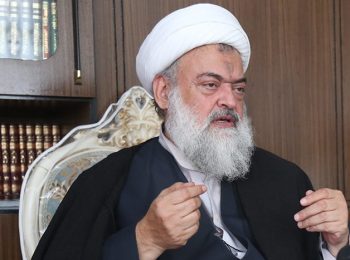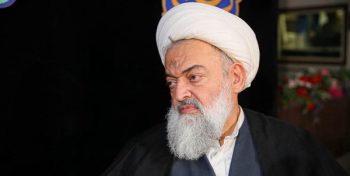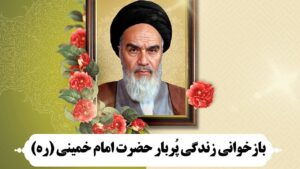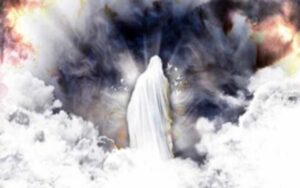Zahra Hadizadeh: The uprising of Mukhtar Thaghafi is one of the most important and historical uprisings in the history of Islam, which happened after the Karbala incident. This uprising started in 66 AH in Kufa and its main goal was to seek the blood of Imam Hussain (AS) and his martyred companions in the Karbala incident. Mokhtar Thaqafi rose against the Bani Umayyad government by chanting the slogan “Ya latharat-e al-Hussein” (ie, bloodthirsty of Hussein).
In a conversation with Hojjat al-Islam Morteza Adib Yazdi, preacher of religion and expert in Islamic studies, we explained the dimensions of Mukhtar Thaqafi’s uprising, including the support of Imam Sajjad (a.s.) and Muhammad Hanafiyyah for this historical uprising.
Hojjat al-Islam Adib Yazdi is a graduate of literature from Tehran University and has studied seminary sciences and courses outside fiqh and principles in the presence of many professors in Tehran. He is currently the head of Bilal Cultural Complex.
conversation Missionary thought and culture base You read with Hojjat al-Islam Morteza Adib Yazdi:

We know that one of the most important events in history is the subject of Mukhtar Thaghafi’s uprising. What grounds and reasons caused the formation of this historical uprising?
After the Ashura event and the martyrdom of Imam Hussain (AS) and his companions in 61 AH, many people of Kufa regretted their failure to support the Imam. With the passage of time, the sense of revenge and the demand for blood increased in Kufa and other regions of Iraq. Mukhtar Thaghafi used this space and was able to gather people around him with the slogan of blood lust for Imam Hussain (AS).
In fact, Mukhtar bin Abi Ubaid Thaqfi was from the Bani Thaqif tribe and was born in Kufa. He was an intelligent person, a politician and a warrior who was about 67 years old at the time of the uprising against Bani Umayyah.
Before his uprising, Mukhtar was one of the companions and accomplices of Abdullah bin Zubair in Mecca and was even in prison for some time due to some political rivalries. However, after his release, he was able to establish himself as the bloodthirsty leader of Ahl al-Bayt.
Mukhtar’s main goal of the uprising was to take revenge on those who were involved in the martyrdom of Imam Hussain (AS) and his companions in Karbala. He decided to pursue the murderers and their accomplices and punish them for their actions. For this reason, the main slogan of his uprising was “Ya Latharat al-Hussein”.
You mentioned that Mukhtar Thaghafi is seeking the blood of Imam Hussain (A) rose up. Did he have anything to do with Imam’s family?
Mukhtar started his uprising in 66 AH from Kufa. With the help of the people of Kufa and different tribes, he managed to take over the government of the city. After the capture of Kufa, Mukhtar began to execute justice against the murderers and criminals of the Ashura incident. Important people such as Umar bin Saad, Shammar bin Dhi al-Jawshan and Harmalah bin Kahl Asadi, who were involved in the Karbala incident, were arrested and executed by Mukhtar’s troops.
As you mentioned in the question, one of the most important topics about Mukhtar is his relationship with Ahl al-Bayt (peace be upon him). Some sources show that Imam Zain al-Abdin (a.s.) did not support Mukhtar and even some historical sources say that Imam Sajjad (a.s.) did not approve Mukhtar’s uprising.
However, Mukhtar attracted the people to him by claiming revenge for the blood of Imam Hussain (AS) and many of those who were loyal to Ahl al-Bayt joined him.
Did you succeed in these activities?
Yes, Mukhtar managed to punish the murderers of Imam Hussain (AS) to some extent. He also sent an army under the command of Ibrahim bin Malik Ashtar to fight against Obaidullah bin Ziyad (the main cause of the martyrdom of Imam Hussain, peace be upon him). In the battle of “Ain al-Worda”, Mukhtar’s army was able to defeat Obaidullah bin Ziyad and kill him.
But in the end, even though he achieved success in the beginning, his uprising was weakened in the end due to some internal problems and a conflict with Abdullah bin Zubair. Mukhtar was besieged in Kufa by the forces of Musab bin Zubair (brother of Abdullah bin Zubair) in 67 AH and was finally killed in the battle.
to Mukhtar’s relationship with Imam Sajjad (A) you mentioned. Specifically, did Mukhtar Thaghafi really get permission from Imam Sajjad for the uprising and seeking the blood of Imam Hussain? In fact, we want the opinion of Imam Sajjad (A) To know about the uprisings.
There are various narrations about Mukhtar’s relationship with Imam Sajjad (AS). Some historical sources claim that Mukhtar started his uprising without the permission and approval of Imam Sajjad (a.s.) and Imam did not support him in any way. For example, Ibn Athir and Tabari stated in their historical books that Imam Sajjad (a.s.) did not approve of Mukhtar’s uprising, and some sources even indicate that Imam distanced himself from Mukhtar.
In some other Shiite sources, it is written that Mukhtar did not have official permission from Imam Zain al-Abdin (a.s.) for the uprising, and he did not directly enter into this affair.
Imam Sajjad (a.s.) generally had an unarmed and peaceful approach to uprisings due to the special conditions and severe political and social restrictions that arose in the post-Ashura period. That Imam focused more on the spiritual, social and cultural aspects of Islam and explaining the position of the Ahl al-Bayt (peace be upon him), and due to this policy, he probably did not officially support the Qiyam Mukhtar.
However, some other historical sources, which are mainly in Shiite sources, believe that Imam Sajjad (AS) approved the Qiyam Mukhtar in some way. Because on the one hand, Mukhtar claimed that his uprising was for the blood of Imam Hussain (AS) and to take revenge on the killers of Karbala, and this goal made him popular with the Shiites and the followers of Ahl al-Bayt.
On the other hand, some sources, especially the Kisaniyyah sect, which are followers of Mukhtar, claimed that Imam Sajjad (AS) had secretly expressed his support for the uprising of Mukhtar, although there is no strong historical evidence for this claim.
Also, some narrations show that Imam Muhammad bin Hanafiyah, the son of Imam Ali (AS) and uncle of Imam Sajjad (AS), supported Mukhtar and even introduced Mukhtar as his representative. Some believe that Imam Sajjad (a.s.) indirectly left Mukhtar’s uprising unanswered due to respect for his uncle.

What is the final historical opinion about this?
Among the Shiite scholars and Islamic historians, the dominant view is that Imam Sajjad (a.s.) did not officially and publicly approve Mukhtar for the bloodthirsty uprising of Imam Hussain (a.s.).
In the period after the Ashura incident, Imam Zain al-Abdin (AS) focused more on spiritual and educational aspects and did not directly interfere in politics due to the intense political and social pressures from the Umayyads. Therefore, although it is possible that Mukhtar revolted with the intention of asking for the blood of Imam Hussain (AS), there is no definite proof that Imam Sajjad (AS) gave him permission or direct support.
As a result, most of the historical narratives indicate that Mukhtar Thaghafi rose without public approval or official permission from Imam Sajjad (AS). However, his uprising with the slogan of blood lust for Imam Hussain (AS) was able to attract a large number of Shiites and supporters of the Ahl al-Bayt (peace be upon him), and because of his revenge against the killers of Karbala, it was recognized as an important Shiite uprising in the history of Islam. to be
What was the role of Muhammad Hanafia in Mukhtar uprising? Is Mukhtar Thaghafi from him for the uprising and bloodshed of Imam Hussain? (A) Did you get permission?
Muhammad bin Hanafiyah, the son of Imam Ali (peace be upon him) from his wife Khula bint Jafar, who was from the Bani Hanafiyah tribe, played an important role in the uprising of Mukhtar Thaqafi. However, this role was not directly in the leadership of the uprising.
Using the name of Muhammad bin Hanafiyah, Mukhtar Thaqfi gained the support of the Shiites and supporters of the Ahl al-Bayt and started his uprising in his name. On the one hand, he claimed to be the representative of Muhammad bin Hanafiyah, and in order to attract the support of the Shiites and legitimize his uprising, he claimed that he was acting as a representative of Muhammad bin Hanafiyah.
He introduced himself as the “lawyer” or “emissary” of Muhammad ibn Hanafiyah and emphasized that Muhammad ibn Hanafiyah, as one of the elders of the Ahl al-Bayt (peace be upon him), allowed him to rise up for the blood of Imam Hussain (as) and his martyred companions. slow This claim was very effective for Mukhtar, because the Shiites at that time were looking for a leader from Ahl al-Bayt who could avenge the blood of Imam Hussain (AS). Since Imam Sajjad (a.s.) did not publicly participate in any uprising due to political and social conditions, Mukhtar took advantage of the popularity of Muhammad ibn Hanafiyah among the Shiites.
With these explanations, Muhammad bin Hanafiyah played an important role in strengthening the position of Mukhtar!
That’s how it is. Mukhtar Thaqafi widely used the name and personality of Muhammad bin Hanafiyah to advance the goals of his uprising. He claimed that Muhammad ibn Hanafiyah was the Imam and the true leader of the Shiites and that Mukhtar was acting as his representative. This claim led to the emergence of a sect called Kisaniyyah, which believed in the Imamate of Muhammad ibn Hanafiyah. It is noteworthy and critical that the followers of this sect believed that Muhammad bin Hanafiyah is the promised Mahdi and that he will appear soon.
Therefore, the name and position of Muhammad ibn Hanafiyah mainly helped Mukhtar to attract popular and Shiite support. Shiites and many people, who were tired of the oppression of Bani Umayyad, joined his rebellion due to Mukhtar’s relationship with Muhammad ibn Hanafiyah.
But note that the issue of whether Mukhtar really received official permission to rise from Muhammad bin Hanafiyah or not is still being discussed. Because it is stated in some sources that Mukhtar started a rebellion without official permission from Muhammad Bin Hanafiyah and only used his name to gain the support of Shiites.
In some other sources, it is stated that Muhammad ibn Hanafiyah indirectly approved Mukhtar, or at least did not seriously oppose him. These sources believe that Muhammad bin Hanafiyah could not publicly confirm Mukhtar due to political and social reasons. In general, it seems that Muhammad bin Hanafiyah did not seriously oppose Mukhtar’s claim, and finally Mukhtar was able to gain the support of the Shiites by using this connection.
A detailed series has been prepared about Qiyam Mukhtar. In your opinion, what were the differences between Mokhtarnameh series and this historical event?
Despite the charm and historical importance of Mukhtar’s story, this series distanced itself from some historical facts due to various reasons such as the limitations of the story and the need for cinematic appeal. One of the cases is highlighting the characters. In the Mukhtarnameh series, the main characters such as Mukhtar and Kisan Abu Umra, or even people like Ibrahim bin Malik Ashtar and Abdullah bin Zubair, were prominently and colorfully displayed. While when we read the history, the role of some of these may be different or less important.
For example, Ibrahim bin Malik Ashtar played a key role as a commander, but perhaps some aspects of his character were overemphasized in the series due to plot considerations.
Another example is Mukhtar’s relationship with Ahl al-Bayt. As I mentioned in some narrations, it is mentioned that Mukhtar’s relationship with Imam Sajjad (AS) was not very strong and reliable. Some historical sources even state that Imam Sajjad (AS) did not support Mukhtar’s uprising. But in the series, this relationship is portrayed in a more positive way.
Another case is the duration of Mukhtar’s rule over Kufa, which is different from reality in the series. At the same time, in order to attract people’s opinion, the story aspects are sometimes increased, while it seems that it would have been better to use the fight and epic aspects. Even some battle scenes and conversations between characters may have been made or exaggerated to make the story more interesting.
منبع: www.khabaronline.ir




